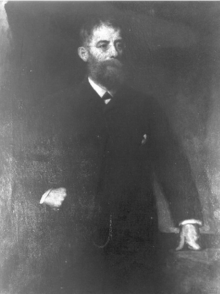John Call Dalton
John Call Dalton[1] (February 2, 1825 – February 12, 1889) was an American physiologist who became the first full-time professor of physiology in the United States.

Early life
Dalton was born in Chelmsford, Massachusetts. He studied under French physiologist Claude Bernard in France. Dalton had two understudies: John Green Curtis and William Stewart Halsted. Dalton and Curtis were associated with the Columbia University College of Physicians and Surgeons in New York. Dalton was a professor of physiology at the college; however, it is unclear whether his son was as well. Dalton received his undergraduate and medical degrees from Harvard University.[2]
Career
The anatomy of the brain was primarily drawn by Europeans prior to Dalton's more detailed and precise sketches of the brain.[3] Dalton received an award from the American Medical Association in 1851 for his essay "Corpus Luteum". He was a professor at the University at Buffalo for a brief time, but resigned in 1854. Dalton served as a professor or chairperson at the Vermont medical college and the Long Island College Hospital.[4] John became the president of the College of Physicians and Surgeons in 1884.[4]
Dalton served as a surgeon in the national service during the American Civil War from 1861 to 1864. Prior to his resignation in 1864, Dalton was a prominent member in the medical corps of the national service. He served in the 7th New York Militia regiment in 1861.[4] Dalton joined the national services as soon as the war commenced. He was primarily a surgeon during this time, and spent a lot of time treating the wounded. John was originally in the US Navy, with the rank of medical officer. However, he spent time as well in the army corps, where he served as the medical inspector in the 6th Army Corps. He was transferred to the Army of the Potomac where he was made chief medical inspector of the field-hospitals. Once Dalton resigned in 1865, he was promoted to brevet lieutenant colonel as well as colonel of volunteers.[4]
Dalton became the sanitary superintendent of the New York Metropolitan Board of Health in March 1866. During the same year in which he resigned from that position, Dalton implemented the ambulance system in New York.
Dalton died of tuberculosis in 1889.[4]
Publications
Dalton's books included The Treatise on Human Physiology. and the Topographical Anatomy of the Brain. The American Academy of Arts and Sciences elected Dalton as a member in 1864.[4]
Works
- A Treatise on Physiology and Hygiene : for Schools, Families, and Colleges. – New York : London : Harper & Bros. ; Sampson Low, Son & Marston, 1869
- A treatise on human physiology : designed for the use of students and practitioners of medicine. – Philadelphia: Blanchard and Lea, 1861
- The Experimental Method of Medicine – Philadelphia, 1882
- Doctrines of the circulation : a history of physiological opinion and discovery, in regard to the circulation of the blood. – Philadelphia : Henry C. Lea’s Son & Co., 1884
- Topographical anatomy of the brain. – Philadelphia, Lea brothers & Co., 1885
Speech
- Vivisection; what it is, and what it has accomplished. - Read before New York Academy of Medicine. Dec 13, 1866
Script : University of Michigan, University Library
Autobiography
- John Call Dalton, M.D., U.S.V.. – [Cambridge: Riverside Press], 1892 ( regarding his brief service in the 7th New York Infantry , National Guard)
References
- "John Call Dalton, M.D." www.MedicalAntiques.com. Retrieved October 1, 2015.
- "Dalton, John Call, Jr. - Oxford Reference". doi:10.1093/acref/9780199766666.001.0001/acref-9780199766666-e-112. Cite journal requires
|journal=(help) - Fine, E. J.; Manteghi, T.; Sobel, S. H.; Lohr, L. A. (September 26, 2000). "John Call Dalton, Jr., MD: America's first neurophysiologist". Neurology. 55 (6): 859–864. doi:10.1212/wnl.55.6.859. ISSN 0028-3878. PMID 10994009.
- Echols, Michael. "John Call Dalton, M.D." www.MedicalAntiques.com. Retrieved November 30, 2016.
Sources
- S. Weir Mitchell: Memoir of John Call Dalton, 1825–1889. In: National Academy of Sciences : Biographical Memoirs. – Washington, DC: National Academy of Sciences, 1985, Band III, S. 177–185.